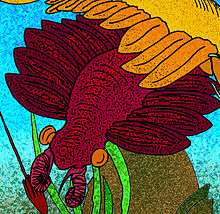Amplectobelua
| Amplectobelua | |
|---|---|
 | |
| Amplectobelua symbrachiata | |
| Scientific classification | |
| Kingdom: | Animalia |
| Clade: | Euarthropoda |
| Class: | †Dinocaridida |
| Order: | †Radiodonta |
| Family: | †Anomalocarididae |
| Genus: | †Amplectobelua Hou, Bergström & Ahlberg, 1995 |
| Species | |
| |
Amplectobelua is an extinct genus of late Early Cambrian anomalocaridid, a group of stem arthropods that lived as free-swimming predators during the first half of the Paleozoic Era. Like other anomalocaridids, Amplectobelua had a pair of jointed grasping appendages, large eyes, a limbless body, and a series of fins or swimming lobes on both sides that extended along the length of its body. It was smaller than the related Anomalocaris, however, and had a specialized grasping appendage, in which the spine on the fourth segment hooked forward to oppose the tip of the appendage, allowing it to grasp prey like the pincer of a crab. The fins differ as well; the front fins are very long and slender, while the middle pair of tail fins are specialized into a pair of long streamers, or furci.
Two species are known, A. symbrachiata from the Chengjiang biota and A. stephenensis from the later Burgess Shale.[1] A. symbrachiata is known from complete specimens, while A. stephenensis is known only from isolated claws. A. stephenensis is more advanced, with the pincer being more specialized for grasping: the fourth spine is larger and the spines on outer segments are reduced.
References
- ↑ Daley, A. C.; Budd, G. E. (2010). "New anomalocaridid appendages from the Burgess Shale, Canada". Palaeontology. 53 (4): 721. doi:10.1111/j.1475-4983.2010.00955.x.
External links
- "Amplectobelua stephenensis". Burgess Shale Fossil Gallery. Virtual Museum of Canada. 2011.
- Anomalocaris Homepage